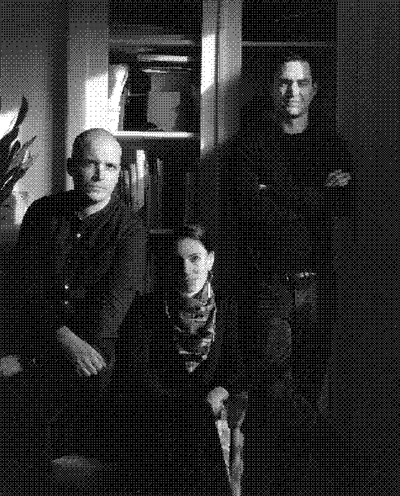Could you please introduce yourselves and describe your current state of mind?
I am Morgan, now managing director of Random Paris Studio, formerly founder and creative director of Bonsoir Paris, a studio created 10 years ago and specialised mostly in 3D spaces; interior, set design, solution design, retail… A lot of installation work like pop‑ups or windows – spaces where we play with your perception.
DL
My name is Daan Lucas, I’m the managing director of the Random Amsterdam office. My state of mind is like everyone else’s. It’s kind of a weird period, with the pandemic everything feels like it’s on hold, we’re waiting but at the same time we started working with Morgan and a lot of things started moving. We’re quite busy – Morgan is actually too busy at the minute. (laugh) So it’s also a really exciting time.


Portait of Daan Lucas
Now that you’ve got Amsterdam and Paris, how do you present Random Studio?
Our work is about interactivity. Well, that’s what I tell my mother for her to understand a bit better. (laugh) The official term is we are an experience design studio – and that counts for both offices. Experience design is a difficult word because everything is an experience and design is also extremely broad – but what we do is we use technology in a spatial way, in a domain where digital meets the physical in what we call an interactive space. We try to create projects that touch the soul and put a smile on your face. As technology entered society and our daily lives, it also caused a huge disconnect: people looking at their phones all the time, spending a lot of time on social media but not meeting people in real life anymore… We always try to use technology to make you aware of where you are, stop thinking or looking at your phone and hopefully become aware of who else is seeing what you are seeing, maybe to create an interaction between you and this other person. We try to use technology in a more human way.


Sketch by Morgan Maccari
You were both creating “experiences” before it was fashionable. Daan, what were your occupations before you founded Random Studio?
I studied law, which is weird because it has nothing to do with what I do now. (laugh) Law is interesting because it’s always had a huge impact on society and is in constant change but at some point I thought I wasn’t going to be a lawyer; I’m way too chaotic and would make too many mistakes!
One thing that was a huge inspiration for me when I was studying was this club called the Roxy. This place was legendary, it changed its interior every six weeks, pioneered different styles of music, and experimented a lot with different performances – some were nasty and really weird, others were mesmerizing.
In this club I noticed that everyone could let go of their ego and really connect with each other and the space itself. After the club burned down I started to organise my own dance parties.
After a while I realised I was not making any money at all and figured I should start a career that would.
Around that time the internet was coming up ad I was very intrigued by the world of what you would then call “new media”. A lot of digital artists, like Geoffrey Lillemon, Joshua Davis, Carsten Schmidt, Universal Everything were experimenting with art, motion graphics, code. I went to a few of these new media festivals, saw really interesting work and wanted to become part of this new movement.
What about you Morgan? Because you also created a job that didn’t exist before, in Paris at least.
It’s hard to reflect on what we do, I think it wasn’t really planned, just like Daan said. I studied graphic design and I ended my studies in 2010 or 2011. And six months later we founded the studio because… we needed to eat, so we needed to work! (laugh). Well, we started eating four years later. (laugh).
In the first place, I was interested in graphic design and architecture. I literally played it heads or tails. It landed on architecture and I remember being a bit disappointed, so I thought: “Oh, it means you wanted to do the other one, so let’s apply for applied arts and graphic design”. This is how I started learning graphic design and everything about image‑making; graphic design but also photography and other things. When we started the studio, I was more an art director for photography. Then we started putting our head into set design because sometimes when you have an idea it’s easier to produce it yourself. We did a couple of editorials where we ended up constructing the scene we designed to make it happen. And with those set designs we worked on a few images that were noticed by some people. They asked if we could do a pop‑up, or installation work, and then it started. We moved away from graphic design and put a feet into the 3D world. From set design to installations, we were then asked: “Do you want to do windows?” and we pitched for windows. Then there was this project we did in 2013 for COS in Salone del Mobile. It was a huge pitch – we didn’t know that, and winning it put us on the map of space design and retail, working on whole concepts for stores and managing these projects from A to Z.

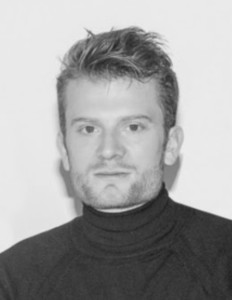
Portait of Morgan Maccari
Morgan, when you started working, coming from graphic design, what were you creative references?
Paul Gaugin (laughs). I remember at the time saying: “If you want to do graphic design, be inspired by everything but graphic design”. It was a kind of strength for us – at least that’s what people have told us. If you are an object designer and pitch for an object, you feel like an object designer and you can’t help thinking about constraints, whereas someone like me with no background in architecture will say: “Oh let’s do this or that!” and then will make it happen. We are not blocked by any references at the beginning and they have always been very broad: from sculpture to graphic design, to Gaugin, to architects… I don’t have precise mood boards in my head or a frame of five big artists I love; it’s very broad.
And you Daan, did you have creative references or things you really liked when you started those nightclubs with Circus?
Don’t say Paul Kalkbrenner! (laugh)
DL
I’m not a designer and I came from law school. I really liked the work of digital artists at the time, it was really a new thing; the work of Geoffrey Lillemon for instance. I saw his work 17 or 18 years ago for the first time and funnily enough, we met at a festival years later, and then he moved to Amsterdam and he’s now one of my best friends. He was one of the people that I really admired when I first started Random. And then Joshua Davis, Carsten Schmidt even the guys from Universal Everything. They have been doing this work for ages and they were really pioneers back in the day.
When you started Random, did you have a plan? What did you think your development could look like?
Say yes Daan, say yes! (laugh)
DL
If a younger person asks me for advice: “What should I do? Should I start my own company?” I would say: “Do five different jobs first, or three at least”. I only had one job for a year and I didn’t really like to work for a boss so I stopped and then I just started and learnt as I went. I made many mistakes – and I am still making mistakes every day, though not as big now. Of course, you learn over time.
So I did not have a business plan, but I did know what I wanted to do from a creative point of view, I knew what I wanted to create: works using technology, art, and design. Work with graphic designers, filmmakers, people who make installations in the physical space.


Chanel project.


Chanel project


Chanel project exterior display
How would you describe your design approach now, in 2021? And especially now working with two offices?
We’ve been working with Morgan for a longer time than just last year. Again, I’m not a designer, but every single person in this company has a part in what we design in the end. Most of the time, I am part of the beginning phase of the projects because I am responsible for new business and if there’s a new client, I want to meet them. So my design approach – and it’s a big part of the quality of the project – is reading the room, making a connection with people: who are they? What are they concerned about? What are they inspired by? And who in our studio can react in a way that is relevant for these people? How do we work with them in a way that they keep feeding the inspiration, the creation and so we’re not afraid that it might go wrong? I really try to tune in… My part is more the tuning in on the human level.
MM
I wouldn’t say our approach is specific to every project because there is a sort of guiding principle. The main idea is to clearly see and understand what’s the point of doing each project. You don’t have to look into it to understand – there may be different levels of reading: the space, an object or scenography – but the feeling, the big picture, must be very clear. Because this is what people will take out. All the projects we do are supposed to create a sort of experience and also be a sort of souvenir. If there is a print of that somewhere in your mind, it must be almost like a logo of what the idea is. So the approach is to – maybe this is what creative direction is in a way – try to start summarising the idea. Then I personally love to establish a kind of pool, almost like a grid and work with it. Projects are made of tons of different people who have the skills to make things grow in ways that will be unexpected, even for me. Then we can polish it, refine it, and develop things so it becomes more and more interesting to look at on different scales. I think this is the perfect way to work.
If you have a client that gives you a bit of freedom to express it in your own way – through the material, the lighting, the entire range of the components of the space… - it’s great!
You’ve both been doing this for over 10 years, how do you make sure you maintain a good level of creativity?
I think our training for multiple years was also to keep on thinking about stuff we were not commissioned for. Sometimes commercial work is a great opportunity to have a budget to make stuff that you could not do on your own. When you don’t have commercial projects, you can develop ideas, concepts, to keep your notebook alive. I’m not gonna say: “I go to the museum” or “I go to Pinterest and Tumblr to put my mood board up to date”. It’s more about taking time to take a step back and look at all the projects you do, and sometimes you can see lines crossing. For example, on one project we worked with sound, and on another with space and sound; maybe there is something with sound that we want to develop. So it could be linked to a technology about sound that we like, and then we think about a special, personal project that could be about that. And tomorrow if you ask us to do something about sound, we will have been thinking about that already. I think that’s how I personally like to proceed: I always have notebooks. I sketch a lot, so sometimes you just have to open your notebooks to see how to implement commercial work into our own ideas.
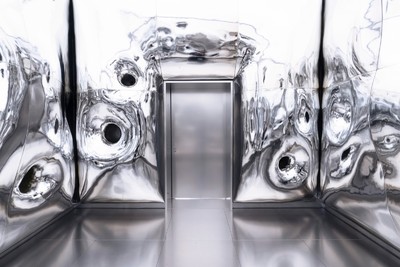

A spatial listening experience for Bottega Veneta


A spatial listening experience for Bottega Veneta
I also remember that a few years ago, you had what you called “wasted time”.
Yes, that is exactly the exercise I was talking about. “Wasted time” was more about making images, so it was an easy exercise in the sense that images are lighter to do than building a space. It’s stuff that you can do without money or budget. That’s what we used to do: close the door of the studio on a Saturday morning and come out on a Sunday night, so at the end of the weekend, you have a couple of images you’re proud of. This is like a fitness exercise.
What about you Daan? How do you maintain a strong level of creativity throughout Random?
Looking back, we have an intrinsic motivation to make new things, to explore: this could be new collaborations, new clients, new tech, new domains. The search for the new feeds our creativity… We went from online only projects to interactive installations and now we are looking in a more holistic way at spaces as a whole and how technology can play a part in giving spaces a certain ever‑changing, interactive behaviour. We thought it could be interesting and therefore we constantly had to learn. Honestly, we had a period where we focused on building the company from a financial point of view more than a creative one. After all those years of running from one project to another, we were looking to build a longer‑lasting relationship with a client so we could grow together and also provide us with financial stability. Now that we have that relationship, I feel there is more room to explore again.


Kinetic window display for Alexander McQueen
This kind of growth crisis happens to many studios. You get a big budget and then you realise it was too big, too soon. What happened then, how did you solve it?
It was financially quite a good time so I didn’t have sleepless nights anymore over money – because that was always the case before: “Am I gonna survive the next three months?” So that was really nice, to finally say: “OK, now we can invest in this, now I can buy a house”, after 10 years of insecurity.
But the problem was that a lot of these people who came to Random did it to do creative work and all of a sudden they were also put on work that was more long‑term, slower, different, more focused on solving business problems than doing more crazy audacious work. That was really difficult. I had to let go some of these people and recruit people who really loved the work we embraced. I had to reshape the team to fit that new dynamic. The studio seems much more balanced now, more professional, we have a strong creative – as well as a business vision.
How would you describe Random’s work culture now?
The way we make the studio look but also the way we organise our processes is quite open. It’s not very hierarchical: it’s really about inviting people to create and we believe that you can only create things when you feel safe, not afraid to get judged on the mistakes you make. So we give people a lot of freedom. There’s not so much control. There is the freedom to shape your own part. Often you see that the way people evolve also defines the way the studio’s direction evolves.
It’s not topdown, I try to see it more as an organism. We work together, we move together, learn from each other, and we back each other up…
But it’s not for everyone, because some people really like to grow in an environment that is very clearcut: “This is what I expect from you and if you hit this target, you will get more money or get a bonus or you get another title”. That’s not really who we are. It is always a balance, of course, you need structure, as without structure there is nothing, however, we are looking for a structure that is needed to stimulate creativity, making things, thinking for yourself, taking ownership. It is a delicate balance.


Random’s office in Amsterdam


Random’s office in Amsterdam
How do you think your ideas have to be presented and pitched to the client?
We did quite a lot of pitches during the 10 years of Bonsoir Paris and we were not bad at making decks and showing the essence of an idea. But when we started collaborating with Random, it was one of the things I was most impressed with: the capacity of a presentation to not only put nice images and references to express what you want to do, but to play with it… Even in the shape of the presentation. With Random, these decks are almost interactive objects. It’s more immersive and you don’t have to associate this image with that one to understand what they mean. It is clearer and playful. Maybe it was also because we were French, we didn’t exactly know how to nicely communicate a concept. The way things are brought to life through words is interesting and charming in the sense that it gives a nice taste to the idea.
You talk about experience so the presentation has to be an experience?
Maybe it’s a bit cliché about interactive design work that the presentation itself is interactive. As we used to be more focused on less interactive things, we didn’t have an idea of how to make a Keynote before. There are still people doing decks that are A4s, not fitting the screen. (laugh)
Do you both have any strategic references?
We started out as a production studio and then started working directly for clients, and now we are starting to become partners with our clients. It’s a logical evolution. When you really want to be a partner for a client you have to have a strategic point of view on the world we both operate in, from a holistic point of view. Not only the market but what is happening in the world on a grander scheme
We don’t have a strategy for our strategy. In this world, things seem to change so quickly that strategy is more about feeling the pulse of the world, what feels right now: “OK let’s try that”, evaluate and take it from there.
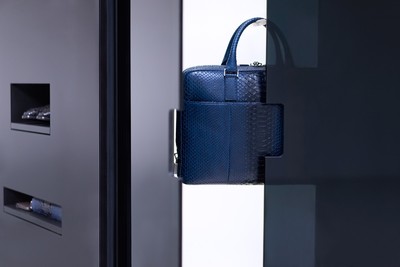

Scenography for Dior


Scenography for Dior
Are there people who inspire you, strategically?
We worked with a philosopher, Andre Platteel, to create a strategy for our studio. As mentioned earlier we live in challenging but also interesting ever‑changing times. We were looking for a strategy that felt more like a fluid construct. Something to refer back to, but also something that was able to change and adapt.
We are talking every week for two hours with Andre to reflect on our vision, how it translates into projects, client relationships, and the studio’s culture…
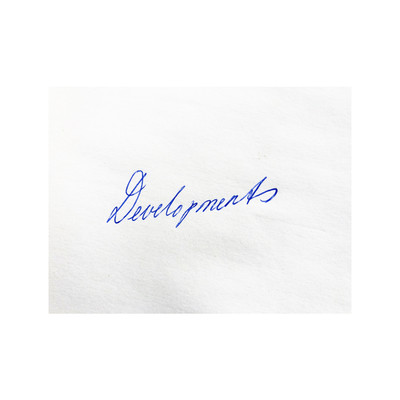
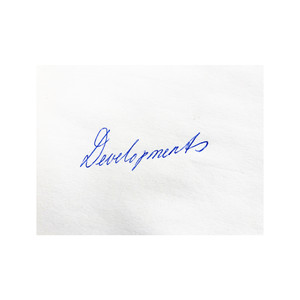
by Daan Lucas
How did you decide to work with that philosopher and to integrate that in your DNA?
I felt this would make the work better and also even more layered. I’ve been talking to Andre for a long time to train myself in how to run the company in a more informed way, not only from a business point of view. I would like us to think more holistically. So when we do a concept, we don’t only make a window or a space that looks cool, but I would like to challenge us to think how the project can surprise people, make them more aware of where they are, with whom they are. We are also thinking about our own position in the world, part of nature.
You went from a production company to a creative studio that can also produce, and now you’re also doing strategic missions, and Research & Development. Are some of your assignments only strategic?
It’s starting to become a little bit like that. It’s very small still, especially the Research & Development part because we see that the clients we currently have struggle – especially now with the pandemic – to spend a substantial amount of money on an activity that does not have a set outcome. With Research & Development, it’s like: “What are we gonna get?” That’s the whole thing: we don’t know yet, we’re gonna explore together and it could be viable but could also hit a dead‑end, and you’ve sent money and we’ve at least learnt that wasn’t right. We can now answer questions that we were unable to answer back in the days. So we see that there is a value there and therefore we want to nourish that and become better at it.

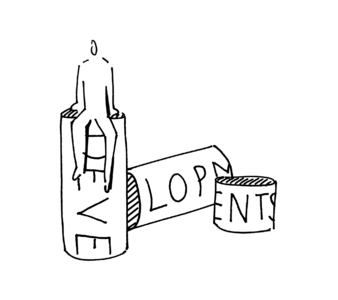
Sketch by Morgan Maccari
How did you approach Morgan and Bonsoir Paris?
We came from an online environment and started making interactive installations but the next step for me was: “OK, how can I create interactive spaces?” Because interactive installations would usually be quite linear: you had a Nike store, “Oh there is something cool there”. You go there, do the thing and then it’s done. What I like so much about the idea of adding technology into a whole space is that the journey isn’t linear anymore. The multitude of people can really change the way the space behaves so we are still in the middle of this journey: what an interactive space exactly is? What could it mean? How could it evolve? But actually, we weren’t such special good designers. I knew Bonsoir Paris from when I started and we always looked at them saying: “Oh these guys make good work”.
MM
I don’t know if you remember but we came to a sort of “studio visit”, eight years ago. We had some stuff to do in Amsterdam and we thought: “Let’s pay a visit to those guys, they make good stuff!”
DL
I remember that! I was really looking for adding that discipline to our already existing mix. I met Morgan a few times and I really liked him, I trusted him I think and his work is really good so this is also what we discussed: “We will figure out the business stuff but between us, it’s good”. And it has been a really good ride so far. It’s intuition I think. We just clicked.
MM
So it’s not only business is it? (laugh) I feel the same in the way that meeting other studios over the years, sometimes you feel a bit: “OK, these ones are competitors” or “These ones are not doing the work like I would like to do it” – everybody is different for sure – but with Random we are not overstepping on each other’s foot. It’s also a strategic business choice because there’s strength in it. It’s not as if a design studio would absorb its exact twin to become bigger: it’s more about sharing knowledge. After 10 years it’s cool to have new challenges and the door we open together is a way for us to stay sharp. Sometimes you can run in circles after a certain amount of time and I think – on my personal level and at this time in my life – I needed a little kick in the ass to stay focus on new stuff and new ideas. I think it was the challenge I was looking for.
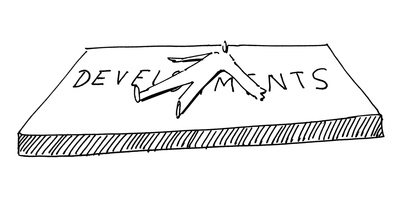

Sketch by Morgan Maccari
What’s the intention now you also have a creative hotspot in Paris? Are there new territories you would like to explore?
One of the important thing is that Morgan is part of the team now, and his team of freelancers like Hassina and the others are really good. We have another discipline on a very high level and we start seeing how we can combine these strengths. I also think it’s very good for people from Amsterdam to work in Paris after Covid and vice versa. It adds diversity. And last thing, we already had a few clients in Paris and it’s nice for Parisian clients to have a local office, for languages purposes but also because it’s just easier.
MM
There are also some clients that we already shared together. We have mutual clients so, to me it was also a way to reinforce some relationships with some clients and definitely to open doors to other clients.
So what will Random be like in three years from now if everything goes well?
We are active on different fronts.
We do more experiential projects – most of the time Morgan does these and we did quite a few together as well – but what I mean by experiential projects is for example a pop‑up shop that is not standard. We always try to make something novel. It could also be an online space. For example, we did an online show for the Antwerp Academy. Those projects are usually one‑offs and quite intense on creative and production levels.
And then we are also doing projects that are a bit of a mix between platform work and these experimental projects because we are exploring what could be the future of work and what could be the future of hospitality, for example. We’re talking to a hotel chain now, for instance. These are longer‑term projects. We started thinking about what could be the experience in a hotel room if we put technology in there. Not to make it like a casino feel – technology should be hidden – but how could a hotel room be in constant motion and adapt to the needs of its visitors? If you want to go to sleep, does the room change to facilitate that? If I want to work in a focused way, how can I do that? If I want to meet other people in the hotel, how can I do that?
We want to become a lot better at doing these experiential projects and we have a plan for that but we also want to see how we can get a grip on these long term projects. Because I also find it is very interesting to look at how it fluidifies architecture, how can a space starts becoming its own agency almost, how can it have a character. Thats a little bit further down but I think we have the right skills for that, to explore that domain.


Ralph working at Random Studio
You handle business development proactively, doing your own research. It’s daring because you spend money and time on this. How do you take that decision, how do you maintain it, and have you already seen any results?
Our new business is not only exploring. People also find us because of our communication and we also have existing clients, so we are not completely dependent on our Research & Development. There are a lot of changes in the market and a lot of clients are asking themselves: “What am I supposed to do with technology in my business? I see technology is everywhere now and how do I work with technology in a way that doesn’t feel cold and stale but also allows me to make money?” So the domain we are in – which is the digital and the merging of the digital and the physical – is actually a very relevant domain for a lot of industries. In that sense, anything we do somehow resonates with a lot of different clients. We never worked for a hotel chain and they found us. Somehow, even the work that we do in retail is relevant to them.


Bottega Veneta Takeover in New-York City


Bottega Veneta Takeover in New-York City


Bottega Veneta Takeover in New-York City


Bottega Veneta Takeover in New-York City
Any ideal project within the next three years? What would be your dream project?
If you had asked me that question six years ago I would have said: “work on Alien set design”. Almost like Giger did back in the days: everything from sketches, develop entire worlds. That was a bit my crazy dream. Now, I don’t know. I haven’t had an opportunity to work on things that are more contemporary like the way brands now have to reinvent the shows and think about a new holistic approach. Not all brands are using the current technologies in the best way. Now that we can’t do fashion shows, we do videos, but sometimes those videos could be something else than just a video that you put online. You have online showrooms that look like catalogues. People had very little time to think about new ways to do stuff because of the context and there are a lot of opportunities to be taken. I would be happy to work on something that answers those questions in a way that is opening new doors for other brands or other projects, or a way to play with all the media, all the channels, all the platforms of a brand to express itself in a very unified way.
How do you think Random’s communication?
We have been pretty bad at it for a very long time. We only started to become better at it last year because we changed the producer’s role into a communication manager’s role and now she actually made sure that we documented all our projects in a professional way. But we’re still struggling a little bit to get these better‑looking cases in publications. We have a very small network of publications that should publish our work. And another thing we need to work on is what I talked about earlier: how we contextualise these case studies in a way that they talk about our holistic vision and not only “OK, we got a job from this client and we produced this in this, and it was open to this and this store blah blah blah”. I think it could be more contextualised by what we believe in.
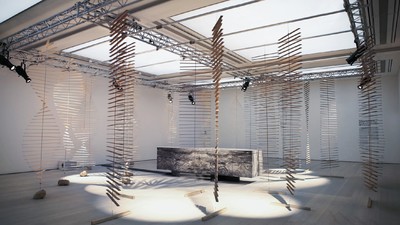
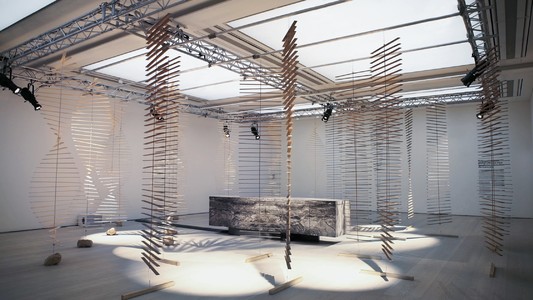
Wallpaper
What are you gonna do with Bonsoir Paris’ Instagram account?
We want to show that we are very much working together on a daily basis, that we are one single voice. On the other hand, it’s hard to kill something that had also its own digital life for a couple of years. That’s one of the questions we are discussing right now. Sometimes the design happens here but the producer of our project lead is in Amsterdam; we can never say that somebody owns the project more than the other because it’s a common work.
DL
The thing that I would find interesting is that the two accounts could have some sort of dialogue with each other because we are the same group if you will, we have a common connection of course, but we are still at different locations and it could be cool to play with that and see an interpretation of a project…
MM
The idea of making these two accounts talking together is funny.
For a design and production company dealing with space, you also love words and you talk very well about your work. Why do you pay so much attention to copywriting? It’s not that common in the creative industries – apart from advertising.
I do like the copywriter. I like the fact that she doesn’t use big words like: “Oh it’s been amazing!” and that she is quite factual. And apparently, to describe a project in its completeness, to describe every single angle that they find relevant, we need a lot of words. I also doubt that people read it. (laugh)
How do you handle, especially for you Daan, managing two offices in two cities in a pandemic time, and the workflow between the two offices?
To be honest, we only started about four months and it wasn’t really busy because of the pandemic. Then we got really busy and Morgan does an amazing job in France: he’s running all his projects there. I have not been doing that much.
MM
I’m definitely not alone!
DL
It’s a bit organic and Morgan hires a lot of good people from his network to deal with projects mostly done in Paris. We also started to work together quite well and we are all used to working from different locations anyway, it doesn’t really matter if you’re in Paris or Amsterdam. Also, I don’t plan so much. I just do a lot of things and make a lot of mistakes and at some point, I find a solution. Morgan and I just went for it and it just fell into place. But there’s not so much work for me to do in Paris because Morgan is doing all that.
MM
You’re not working more now that you have offices in Paris? Are you sure? I’m always asking questions and we do also some management together… It’s so cool to have you Daan, you’re like a business Daddy: you have more experience in your stuff… I’m more project‑focused and you are more business‑focused. I’ve always had partners in the past, so discussions over partners were always there, but it’s always great to feel backed up in a way, and you give a lot of advice. So on my side, it makes things easier, I feel more confident in where we are going, and how we are doing and also willing to do better.
DL
I guess what happens for me is a bit of a focus shift. I think I was much more on a project base as well, I always knew about most of the projects. Now I think I’m trying to figure out stuff on another level. I don’t think I work more, it’s just a focus change. I am more looking at it from the outside.
[Morgan has to leave]


Kinetic architecture for A/D/O by MINI
Daan, what’s your view on the creative scene and its evolution?
A lot of people realised – because of the pandemic – that we have to change our ways. There is a change in the way we look at ourselves, at others, and the world as a whole.
We are looking to become a B‑corp within a few months, we hired a sustainability manager and in our works we try to put humans first. How can we surprise people, give them a sense of wonder, make them aware – of themselves, the others and the space they are currently in?
What do you observe among the young creative talents?
Funnily enough, I still see a lot of graphic design in people. And I don’t see a lot of people who work with technology in the design world. That is strange because technology is so incredibly present in our daily lives… What I do see in a lot of students is that they are embracing sustainability, which is comforting.
If you could do a similar job at any other time in any historical area, what kind of job would it be and at what times?
I would like to be an architect, I always wanted to be an architect but my maths skills weren’t up to speed at all, which was a real shame. I would love to be an architect now, because now with all the technology, the design process doesn’t stop once you’ve delivered the key: an architect can now start thinking about how a space can change over time, how it can be responsive, interactive. I find that fascinating. This is why Random is focussing on this domain.


Random’s future office


Random’s future office
Are there books that have helped you in your career?
I’m not a huge reader, funnily enough, I’ve always pained myself that I don’t read or research enough. There’s one book that a friend of mine gave me on my birthday and it’s called One, No One, and One Hundred Thousand and it’s about a protagonist who understands that everyone looks at him in a different way and he becomes aware of the fluidity of identity. I read this book 10
years ago and it kicked off my spiritual journey. I still have an ego, I still have fears, left and right, but I also know that it’s not reality. In the exploration, I feel free and that book did it for me – I know there are many many other ways of getting there but if I would have to name a book it’s this one. It’s by an Italian writer, Pirandello.
Is there also, in a similar way, an artist or someone who’s helped you in terms of developments? You mentioned a spiritual journey…
It’s my friend Andre Plattee, the philosopher I talked about earlier. We get together often and explore life in general. We look at ourselves, our own patterns and give each other feedback. On our personal and work life. You can’t separate these. My fears will be projected on my sons as well as our staff, clients. etc. And vice versa. It really helped to start understanding my own dynamics. Andre also really helped me, advised me, on how to work with staff, where do you project your reality and your fear on someone and where does the other person start. How can you create space for the other to feel safe in a studio like ours – but I guess there are moments of tension between people everywhere. And I want to try to have a culture where irritation, fear or whatever is blocking us, can be discussed and resolved, and so build trust and grow together.
What would your advice for creative talents starting a career nowadays be?
People are looking at what is already out there. I get a lot of portfolios from people who want to do an internship or want to apply for a job here and when you look at those portfolios you see the same stuff that you see everywhere… If you’re young it’s hard to have your own style immediately. I talked to a film director once and he said: “I copied work for seven years before finding my own signature”. I think it would be good for people to not look at all the blogs, not look at Instagram, but rather do work, really try to do it from their own intuition and just make stuff and not be afraid of what anyone in the design community would feel.
Work that you haven’t seen before or that touches something new is always more interesting. It would be better to create your own references. That would be a good task for students I think, not to look at what’s out there, really try to isolate from that a little bit.


